Suleymaniye Mosque
The Magnificent Mosque of Istanbul
 The Magnificent Mosque of Istanbul: Süleymaniye Süleymaniye Mosque, one of the most important works of Ottoman period architecture, is located in the Eminönü district of Istanbul.
The Magnificent Mosque of Istanbul: Süleymaniye Süleymaniye Mosque, one of the most important works of Ottoman period architecture, is located in the Eminönü district of Istanbul.
It was built by Mimar Sinan between 1551 and 1557, by order of Sultan Suleiman the Magnificent. The mosque, which is part of the Süleymaniye complex, the second largest complex of the Ottoman Empire, is located on the highest hill overlooking the Golden Horn, the Sea of Marmara, Topkapi Palace, and the Bosphorus. Süleymaniye Mosque, which is considered one of the most important examples of classical Ottoman architecture and is the masterpiece of Mimar Sinans kalfalık (mastership) period, has a great value in terms of cultural heritage. The dome of Süleymaniye is 53 meters high and 27.5 meters in diameter.
This main dome is supported by two semi-domes, as seen in Hagia Sophia. The mosque, which has 32 windows on the dome drum, has one minaret in each corner of the courtyard. The historical mosque, which has a simple structure in terms of decorations, has stained glass windows in the windows of the mihrab wall. The Fetih (Conquest) Surah is written on the tile medallions on the windows on both sides of the mihrab, and the Nur (Light) Surah is written in the middle of the main dome of the mosque.
The calligrapher of the mosque is Hasan Çelebi. The mosque has four minarets and ten balconies. Two of the minarets have three balconies, while the other two have two balconies. The minarets called mosque minarets and harem minarets indicate that Kanuni was the fourth sultan with the conquest of Istanbul; ten balconies indicate that he was the 10th sultan of the Ottoman Empire. There is also a tomb on the qibla side of Süleymaniye, which contains Sultan Suleiman the Magnificent and his wife Hürrem Sultan.
Despite the fact that more than a hundred earthquakes have occurred in Istanbul since the construction of the mosque, the walls of the historical structure have not cracked in the slightest. Süleymaniye Mosque, one of the most important cultural heritages of Istanbul, welcomes millions of visitors every year and showcases the cultural richness of Istanbul.